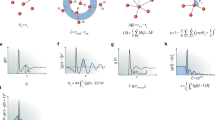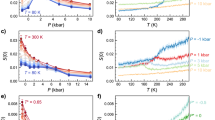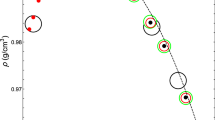Abstract
In contrast to crystalline solids—for which a precise framework exists for describing structure1—quantifying structural order in liquids and glasses has proved more difficult because even though such systems possess short-range order, they lack long-range crystalline order. Some progress has been made using model systems of hard spheres2,3, but it remains difficult to describe accurately liquids such as water, where directional attractions (hydrogen bonds) combine with short-range repulsions to determine the relative orientation of neighbouring molecules as well as their instantaneous separation. This difficulty is particularly relevant when discussing the anomalous kinetic and thermodynamic properties of water, which have long been interpreted qualitatively in terms of underlying structural causes. Here we attempt to gain a quantitative understanding of these structure–property relationships through the study of translational2,3 and orientational4 order in a model5 of water. Using molecular dynamics simulations, we identify a structurally anomalous region—bounded by loci of maximum orientational order (at low densities) and minimum translational order (at high densities)—in which order decreases on compression, and where orientational and translational order are strongly coupled. This region encloses the entire range of temperatures and densities for which the anomalous diffusivity6,7,8,9 and thermal expansion coefficient10 of water are observed, and enables us to quantify the degree of structural order needed for these anomalies to occur. We also find that these structural, kinetic and thermodynamic anomalies constitute a cascade: they occur consecutively as the degree of order is increased.
This is a preview of subscription content, access via your institution
Access options
Subscribe to this journal
Receive 51 print issues and online access
$199.00 per year
only $3.90 per issue
Buy this article
- Purchase on Springer Link
- Instant access to full article PDF
Prices may be subject to local taxes which are calculated during checkout






Similar content being viewed by others
References
Ashcroft, N. W. & Mermin, N. D. Solid State Physics (Saunders College Publishing, Fort Worth, 1976 ).
Torquato, S., Truskett, T. M. & Debenedetti, P. G. Is random close packing of spheres well defined? Phys. Rev. Lett. 84, 2064– 2067 (2000).
Truskett, T. M., Torquato, S. & Debenedetti, P. G. Towards a quantification of disorder in materials. Distinguishing equilibrium and glassy sphere packings. Phys. Rev. E 62, 993–1001 ( 2000).
Chau, P.-L. & Hardwick, A. J. A new order parameter for tetrahedral configurations. Mol. Phys. 93, 511– 518 (1998).
Berendsen, H. J. C., Grigera, R. J. & Stroatsma, T. P. The missing term in effective pair potentials. J. Phys. Chem. 91, 6269–6271 (1987).
Ruocco, G., Sampoli, M., Torcini, A. & Vallauri, R. Molecular dynamics results for stretched water. J. Chem. Phys. 99 , 8095–8104 (1993).
Prielmeier, F. X., Lang, E. W., Speedy, R. J. & Lüdemann, H.-D. Diffusion in supercooled water to 300 MPa. Phys. Rev. Lett. 59, 1128–1131 (1987).
Angell, C. A., Finch, E. D., Woolf, L. A. & Bach, P. Spin-echo diffusion coefficients of water to 2380 bar and -20 °C. J. Chem. Phys. 65, 3063–3066 (1976).
Scala, A., Starr, F. W., La Nave, E., Sciortino, F. & Stanley, H. E. Configurational entropy and diffusivity of supercooled water. Nature 406, 166– 169 (2000).
Debenedetti, P. G. Metastable Liquids. Concepts and Principles (Princeton University Press, Princeton, 1996).
Tanaka, H. Simple physical explanation of the unusual thermodynamic behavior of liquid water. Phys. Rev. Lett. 80, 5750– 5753 (1998).
Tanaka, H. Two-order-parameter description of liquids: critical phenomena and phase separation in supercooled liquids. J. Phys. Condens. Matter 11 , L159–L168 (1999).
Tanaka, H. Simple physical model of liquid water. J. Chem. Phys. 112, 799–809 (2000).
Shiratani, E. & Sasai, M. Molecular scale precursor of the liquid-liquid phase transition of water. J. Chem. Phys. 108, 3264–3276 (1998).
Paschek, D. & Geiger, A. Simulation study on the diffusion motion in deeply supercooled water. J. Phys. Chem. B 103, 4139–4146 (1999).
Sciortino, F., Poole, P. H., Stanley, H. E. & Havlin, S. Lifetime of the bond network and gel-like anomalies in supercooled water. Phys. Rev. Lett. 64, 1686– 1689 (1990).
Sciortino, F., Geiger, A. & Stanley, H. E. Effect of defects on molecular mobility in liquid water. Nature 354, 218– 221 (1991).
Soper, A. K. & Ricci, M. A. Structures of high-density and low-density water. Phys. Rev. Lett. 84, 2881–2884 (2000).
Bellissent-Funel, M.-C. Is there a liquid-liquid phase transition in supercooled water? Europhys. Lett. 42, 161–166 (1998).
Angell, C. A. & Kanno, H. Density maxima in high-pressure supercooled water and liquid silicon dioxide. Science 193, 1121–1122 (1976).
Poole, P. H., Sciortino, F., Essman, U. & Stanley, H. E. Phase behavior of metastable water. Nature 360, 324–328 (1992).
Sciortino, F., Kob, W. & Tartaglia, P. Inherent structure entropy of supercooled liquids. Phys. Rev. Lett. 83, 3214–3217 (1999).
Stillinger, F. H. A topographic view of supercooled liquids and glass formation. Science 267, 1935–1939 ( 1995).
Goldstein, M. Viscous liquids and the glass transition. A potential energy barrier picture. J. Chem. Phys. 51, 3728– 3739 (1969).
Mishima, O. & Stanley, H. E. The relationship between liquid, supercooled and glassy water. Nature 396, 329–335 (1998).
Speedy, R. J. & Angell, C. A. Isothermal compressibility of supercooled water and evidence for a thermodynamic singularity at -45 °C. J. Chem. Phys. 65, 851– 858 (1976).
Angell, C. A., Oguni, M. & Sichina, W. J. Heat capacity of water at extremes of supercooling and superheating. J. Phys. Chem. 86, 998 –1002 (1982).
Tombari, E., Ferrari, C. & Salvetti, G. Heat capacity anomaly in a large sample of supercooled water. Chem. Phys. Lett. 300, 749– 751 (1999).
DeFries, T. & Jonas, J. Pressure dependence of NMR proton spin-lattice relaxation times and shear viscosity in liquid water in the temperature range -15 to 10 °C. J. Chem. Phys. 66, 896–901 (1977).
Mishima, O. & Stanley, H. E. Decompression-induced melting of ice IV and the liquid–liquid transition in water. Nature 392, 164–168 ( 1998).
Naberukhin, Y. I., Voloshin, V. P. & Medvedev, N. M. Geometrical analysis of the structure of simple liquids: percolation approach. Mol. Phys. 73, 917 –936 (1991).
Nettleton, R. E. & Green, M. S. Expression in terms of molecular distribution functions for the entropy density in an infinite system. J. Chem. Phys. 29, 1365– 1370 (1958).
Allen, M. P. & Tildesley, D. J. Computer Simulation of Liquids (Clarendon Press, Oxford, 1990).
Acknowledgements
We thank T.M. Truskett and S. Torquato for discussions. This work was supported by the US Department of Energy and Unilever Research.
Author information
Authors and Affiliations
Corresponding author
Rights and permissions
About this article
Cite this article
Errington, J., Debenedetti, P. Relationship between structural order and the anomalies of liquid water . Nature 409, 318–321 (2001). https://doi.org/10.1038/35053024
Received:
Accepted:
Issue Date:
DOI: https://doi.org/10.1038/35053024
This article is cited by
-
Microscopic mechanisms of pressure-induced amorphous-amorphous transitions and crystallisation in silicon
Nature Communications (2024)
-
Structure and thermodynamics of water adsorption in NU-1500-Cr
Communications Chemistry (2023)
-
Tailoring water structure with high-tetrahedral-entropy for antifreezing electrolytes and energy storage at −80 °C
Nature Communications (2023)
-
Impact of hierarchical water dipole orderings on the dynamics of aqueous salt solutions
Nature Communications (2023)
-
Clustering of charged colloidal particles in the microgravity environment of space
npj Microgravity (2023)
Comments
By submitting a comment you agree to abide by our Terms and Community Guidelines. If you find something abusive or that does not comply with our terms or guidelines please flag it as inappropriate.



